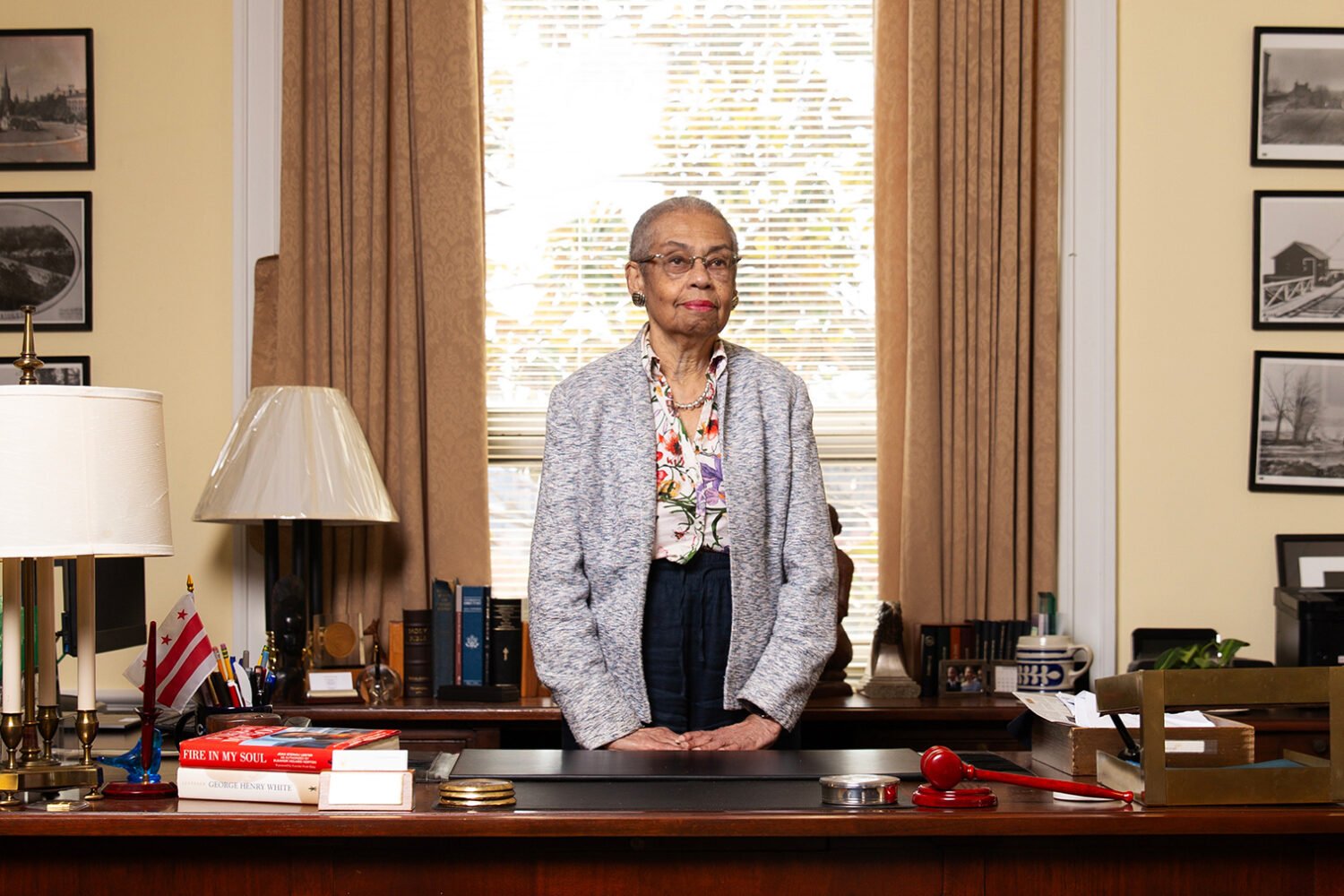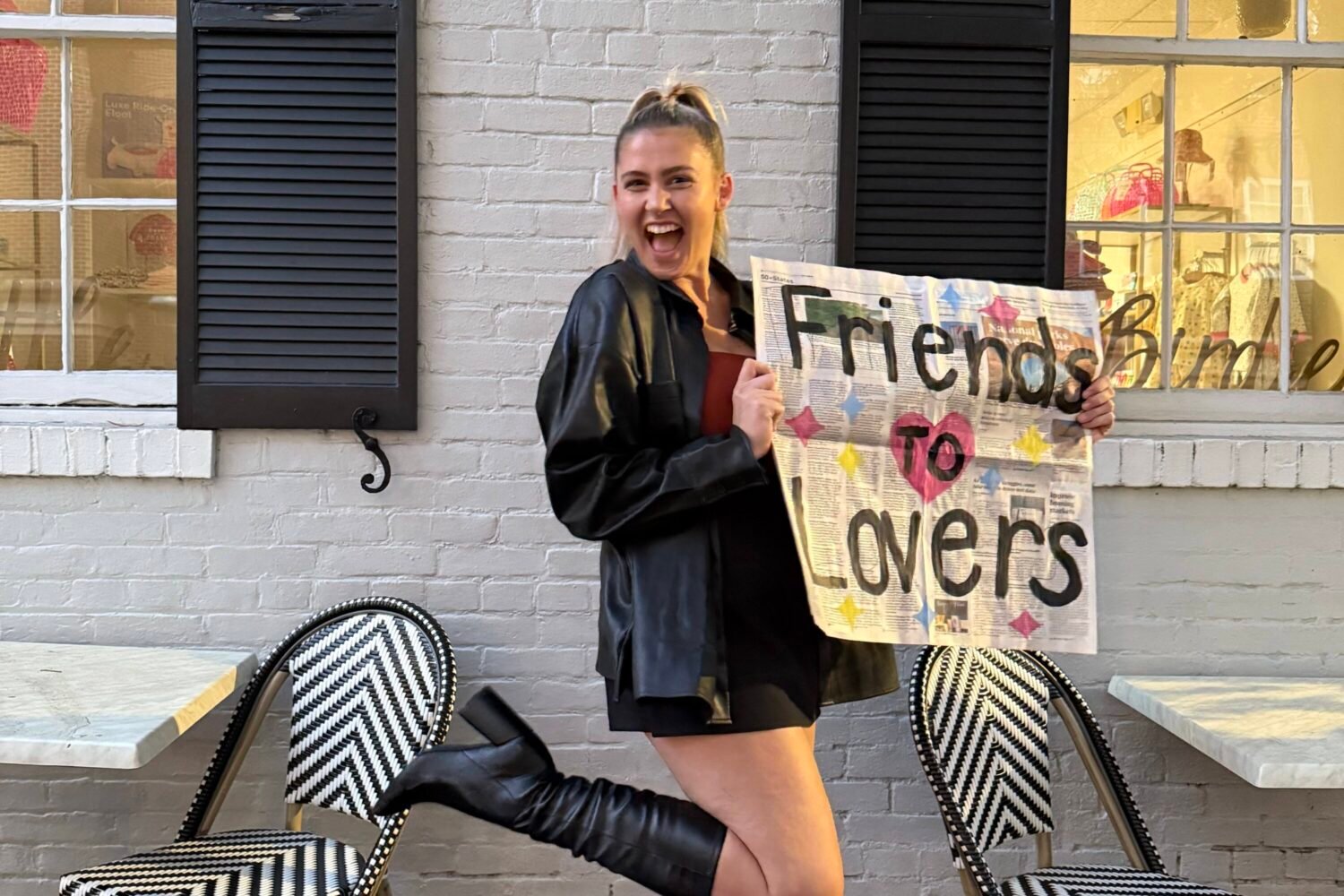Libby Rasmussen has a sublime ceramic ass. It’s one of the first things you notice in her bedroom—its two rounded moons taut and bethonged, perched near a stack of Hermès boxes and a succulent, lording over the space like a benevolent god from its pile of arty books. The mountaintop pinnacle of the swooniest Instagram daydream.
Rasmussen, an event planner who’s 28 and blond and has 10,000 Insta followers (obviously), is a little like the Holly Golightly of Columbia Heights, always out to drinks with friends or at a concert or new restaurant. When she does sleep, she does so under a velvet-draped ceiling and a neon sign that reads I’M THAT FIRE KIND, glowing like the iPhone screens of the fans who stalk her feed.
Today, though, she’s hosting an open house—a casting call of sorts. Rasmussen has lived in her three-bedroom apartment at 14th and Irving for four years, during which she estimates that ten people have circulated through the other two bedrooms. Most have left to embark on the millennial version of Birthright—either moving to New York or moving in with a boyfriend—at which point she has to go through it all again. Post the rooms on Craigslist and Facebook, wade through the inquiries, filter out the crazies, start the interviews, select a few finalists. Then, like a silhouette shimmering on a postapocalyptic vista, one will be left: the designated survivor. Her new roommate.
The vying for those slots or other shared housing has become reality-TV-like.
This time, both housemates are moving out (no New York, just boyfriends), so Rasmussen has several interviews scheduled. She isn’t too worried about finding someone, however, and for good reason: The place is well decorated in the way most well-decorated things are these days, with midcentury touches and minimalist graphic art galore. It’s clean and affordable (each room is in the acceptable $1,400 range), with plenty of light and a good location—a straight flush, if you will.
In less than a few days, she’s had 100 inquiries via social media—the onslaught got to be so much that she deleted her post. Four finalists are coming by today, with more scheduled for next weekend. “It was a lot,” says Rasmussen. “It’s just, like . . . .” She throws her head back against the sofa, glittery sneakers hitting the faux-Oriental rug. “Ughhh, let’s get this over with.”
And it will be over with, as soon as the finalists do what one does in today’s social-media galaxy: that is, sell their best selves. During the tour, Rasmussen mentions she likes yoga, and a woman volunteers that she’s a yoga instructor and would be glad to lead some flows in the apartment. Another says she has a cute armchair she can contribute, and someone else has a set of Anthropologie dishes that would be perfect. One woman works at Facebook and casually mentions that her roommates are automatically invited to company events.
When Rasmussen points out the Starbucks and Cava across the street, all of their mouths drop into hollow, choreographed ooooohs, ringing like perfect bells in an empty church.
“This is nice,” whispers one, sounding both reverential and mournful.
“This is, like, the best-decorated apartment I’ve seen in a long time,” says another. “Usually it’s, like, $1,500 for shit English basements. We saw this and were like, ‘Is this for real?’ ”
Rasmussen laughs. Oh, it’s for real.
You’d have to live in a soundproofed, rent-controlled penthouse not to know that there’s a bit of a housing issue going on in DC. Our 68-square-mile city has added north of 100,000 people since 2010. Yet the recent building boom hasn’t necessarily helped: Last year alone, 91 percent of apartment complexes built in the District were estimated to be high-end, according to the commercial real-estate research firm Yardi Matrix. In low-income communities, the situation is a crisis. For new graduates migrating to the capital—an ambitious, competitive demographic that’s been navigating the rental market since basically the beginning of the Republic—it has introduced a whole new arena of ambition and competition into the culture.
As a place that draws throngs of young newcomers but lacks a Manhattan-like supply of apartments, Washington has always been big on shared living. Group-house arrangements that might seem bohemian elsewhere are the stuff of normal, conventional twentysomethings (and thirtysomethings) here. But over the past ten years, the vying for those slots, or in some other sort of shared housing, has become reality-TV-like. Instead of simply passing a credit check or knowing a dude who knows a dude, scoring affordable housing is now a question of proving your Itness against a barrage of other hopefuls—or sitting through more interview rounds than for a consulting job at Deloitte.
It’s not enough simply to be a good housemate, someone who’ll clean up her dishes and buy toilet paper and not drink someone else’s wine. No, you have to stand out, brand yourself, really shine. In short, you have to be the best, coolest, most fun roommate ever. Of all time.
Because, hey, if it were you and you could spread the word about an open room in your place to 3,000 of your BFFs with a quick status update, why wouldn’t you pick whoever has the most curated profile pic or the coolest vacation photos from Tulum?

“It’s just a lot of pressure,” says 30-year-old Sarah Hutson, who works in public affairs and on one search went to 30 open houses. “I suspect that I stood out to them because I spoke Chinese and I didn’t like kale, which made them laugh,” she says of the interview that finally landed her a spot. “It was, like, kind of a weird X-factor thing. Hard to predict.”
Between 2012 and 2015, Christine Driscoll lived in four different shared homes, so she’s a gold medalist in scouring listings. Her record is also 30 open houses between moves, including a co-op (“It smelled like pets”) and several awkward meet-and-greets (“You know when someone makes really intense eye contact?”)—an ordeal so singularly DC that she filmed a whole video series about it. She eventually moved to New York.
“I remember being like, ‘Ugh, if I just worked for the Center for American Progress.’ I feel like if you worked there, you’d have your pick of places to live,” says Driscoll, who instead wrote research reports as an analyst for a consulting group. “Everybody wanted someone to move in who could help them get a better job or meet more interesting people because so much of DC is, like, work.”
Keeping up with the group-housing Joneses is especially difficult when you’re moving to Washington from out of town, as many people do. You’re stalking Craigslist from your parents’ basement in Buffalo Grove, Illinois, counting down the days until your move date, and the Joneses, well, the Joneses are cracking jokes about kale at open houses in DC.
Sam Alhadeff can tell you. Last summer, he was home in suburban Chicago trying to use Facebook to score a place to live during his pending DC internship. The response had been lackluster—he’d found only a converted sunroom and a basement without a closet, both in less-than-ideal locations. “I figured to find an apartment that really fit everything I was looking for, I needed to set myself apart a little bit and get the eye of the people who have the best ones,” he says.
So he did what any eager recent graduate would do—made a résumé, duh.
Instead of PowerPoint skills or volunteer service, Alhadeff listed selling points such as owning a 65-inch HD TV (complete with Netflix, Hulu, HBO Go, and Amazon Prime subscriptions), taking phone calls in the other room, and showering quickly. The whole thing took him two hours, save for the tweaks he made after sending it around to his parents and friends. (There was a lot of back-and-forth about whether he should list his GPA; he decided against.)
Alhadeff posted it, and the response was immediate. “There were so many [inquiries and comments] at that point that it was overwhelming.” He says the résumé helped him land the prime apartment he now calls home—a big room in Columbia Heights, close to the Metro, and all for a sweet, sweet $800 a month.
Good for Alhadeff, but what happens to the people who feel so crushed by the competition that they literally can’t deal? Well, they’re millennials, remember, which means there’s no shame, in the midst of a big, daunting competition, in calling in . . . Mom.
Last year, Jaya Venkataraman’s 21-year-old daughter was working ridiculously long hours on Beto O’Rourke’s Senate campaign, often from seven in the morning till ten at night. She needed to find housing before starting her next job, so Venkataraman came to the rescue. Luckily, she had experience: She had helped her daughter secure housing for her two previous summer internships in DC (stories she tells in the royal we, as in “We almost got scammed”).
Thanks to this latest bit of mom-powered elbow grease, her daughter is now in a two-bedroom with two other girls (one sleeps in a makeshift bedroom) for about $1,200 a month. It’s clean and in a central location (Chinatown), and perhaps best of all, Mom thinks it’s safe.
They’re millennials, so there’s no shame, amid a big competition, in calling in . . . Mom.
“I wonder if people thought she’s unable to make her own decisions,” Venkataraman muses, pausing on the phone. (To be fair, she isn’t the only parent negotiating with would-be housemates on behalf of the kids: A coworker of mine who posted an $1,150 room in his H Street house was contacted by two different parents.)
“I could have just gotten [her login info] and pretended to be her,” Venkataraman says. “But . . . .” She trails off. There’s a line even Mom won’t cross.
Ask any legit group-house occupant what an open house is like and you’ll hear several analogies used over and over: It’s like sorority rush, speed dating, a job interview, going on Survivor.
And because the people with the keys in their hands are the ones in demand and because, hell, why not, sometimes they decide to raise the stakes a little. Which, sure, makes sense for them but also creates a few existential crises for those searching for a roof, any roof, to put over their heads.
When 24-year-old Brandon Honeycutt found his apartment on Facebook last fall—a four-bedroom in Logan Circle—the Capitol Hill staffer immediately jumped on it. I ask him how much he pays. “Six-eighty,” he says sheepishly. But not, like, too sheepishly—after all, it took him no less than eight weeks to get in there. “I felt like I was on a game show the entire time because there were so many different rounds of competition I was trying to get through,” he says.
First he submitted an initial inquiry, then filled out a Google survey requesting background information and answers to such questions as “What can you offer to the house?,” “Are you LGBTQ-friendly?,” and “Do you have a sense of humor?” Next he filled out a Doodle Poll outlining his interview availability, then went into the first round, in which the roommates asked him what he did with his free time, how often he went out, and so on. He passed and went back for a second round, at which point it was all about gauging the chemistry. Yeah, he could keep a bathroom clean, but would he really gel with the crew on another plane?
And then—deep breath—“I got an e-mail the next night saying, ‘Congratulations! You’ve been chosen,’ ” he says. “I felt like I had finally won the final rose on The Bachelor or something.”
Others share stories of having to create a meme (internet illiterates need not apply), playing Apples to Apples to have their capacity for fun assessed (better throw down the best card or you could be homeless!), being asked which Harry Potter house they’d be in (to be fair, no one wants to live with a Hufflepuff), or, in the words of a 23-year-old who works in cryptocurrency and just moved out of an Adams Morgan group house—sitting “in a f—ing circle” to play icebreakers with 20 other candidates.
The most common test, though? Housemates asking you to bring beer, the general consensus being that the more esoteric, craft, and small-batch your selection, the cooler you are. When Hutson, the kale hater, showed up at an open house near Columbia Heights with a six-pack, she figured she’d have one or two drinks, get to know the housemates, then head home. But everything felt immediately very outside of the DC de rigueur. Instead of Brooks Brothers button-downs with rolled-up sleeves or sensible commuter shoes—that classic Washington yo-pro uniform—the housemates had long beards and were hanging out in flannels: “I was like, these people seem more like Vermont people than DC people, but okay.” She needed a room, and the game had to be played.

Everyone headed to the back porch, where they cracked open some of the beers and the housemates, a mix of guys and girls, started telling stories: Just a warning, they said, the stray cats that sometimes hung out around the house may have bitten someone, and they liked to have parties—someone got so wasted once, they couldn’t find the bathroom and just shit in the back yard.
Hmm, thought Hutson, but she’d budgeted the time (and the six-pack), so, well, she might as well stick around a little longer. Then they asked if she wanted to see the photos—you know, the life-size pics of all the roommates posing naked but for strategically placed volleyballs or hats, photos they then started pinning up on the living-room walls.
“By then I was just like, ‘Okay, yeah. Not living here,’ ” says Hutson. “It definitely did seem like they were looking for someone who was cool enough to join their house. And I was like, ‘I’m not cool enough for you guys.’ ”
Oh, yeah—there was a pet snake in the basement, too.
For those who stick it out, who story-board the memes and brave the icebreakers to move-in day, it isn’t always one big adult slumber party from there. In a transient place like Washington, group houses are Petri dishes, the living organisms in them growing and breaking apart and reforming, dividing mitochondria of friendships and hookups and rooming arrangements. That is to say, some crazy shit is bound to happen.
You’ve got the weirdos who still somehow manage to slip through, says Ryan O’Leary, a 28-year-old who in 2016 worked in political communications and lived in a LeDroit Park group house. Take the hoarder, for instance (“It was the scariest thing we’d ever seen,” O’Leary says of the piles of old clothing, the bed covered in mustard and ketchup jars), or a former police officer who, after she started having outbursts, disappeared, he says. Some cops showed up to look for her, decided to search her room, and found it empty save for a mattress on the floor and a vibrator.
Still, against the rental backdrop of 2019, a lot of deal-breakers don’t necessarily lead to a broken deal. Take Will Peischel, who moved here from California in January for a Washingtonian editorial fellowship. He’d arranged a place to live but had only seen photographs of it. Which is why he had no idea nine people were crammed into an ostensible four-bedroom house. “There’s one person on the first floor, four of us on the second floor, and one person in the attic, which makes six, plus three in the basement.” He pauses, as if to set up an ominous flash-bang of lightning and thunder across the sky—crack. “And then Kenneth in the back yard.”
Back Yard Kenneth is exactly like he sounds—a dude named Kenneth who lives in the back yard. “I went into the yard to smoke a cigarette,” says Peischel, “and realized I was in someone’s front yard.” As in next to Kenneth’s van.
Others had to create a meme, play Apples to Apples, say which Harry Potter house they’d live in.
It was pretty well furnished, with a rug on the floor, a range, a little bathroom area. (Back Yard Kenneth got all the inspiration for his van from watching YouTube videos, Peischel says he told him.) He just pays rent for the parking spot, and each morning he fires up the vehicle and chugs across the river to his job in Northern Virginia. After work, he chugs back to DC, puts it into park, and settles in. Ahhh, there’s no place like van.
Unless you’re more of a shed guy.
Because yes, believe it or not, conditions are so tight (and landlords apparently so vulturey) that you can now walk the back alleys of a bougie neighborhood in Washington and happen across someone’s vinyl front door.
An Alexandria resident I’ll call Joe told me about how in 2011 he was 25 and “broke poor,” tutoring and working at an afterschool program during what he calls “the futon situation,” when he slept on a sofa in a room with four other people. (The apartment was across from the zoo—in the morning, you could hear the lions roar.) Then came an opportunity to live for cheap in a shed—an actual hey-I’m-going-to-go-grab-the-lawn-mower, eight-by-ten Home Depot shed.
“I was like, you know what—I grew up in the country, I love camping. I’ve just lived in weird places my whole life. Like, nothing bothers me, I’ll do it. It’ll be a funny thing.” He laughs the laugh of a man now comfortably living in a legal structure with running water. “And yeah, so that’s how I moved into a shed.” Also, he was desperate and it was $700 a month.
The dwelling sat in the back yard of a house in Del Ray, which he says an older woman rented out to nine or ten people a time. The list of housemates reads as if the Island of Misfit Toys and The Real World had a baby: a British sword fighter who worked at a medieval restaurant, a cabdriver with a wallful of TVs and computer screens who spent his days betting on horses, a South American college student who slept in a closet under the stairs.
But back to the shed. It was drywalled, with a small window cut into one of the walls. An extension cord ran to it from the main house, Joe says, so he could have lights and a space heater. Sometimes the landlady, a little forgetful in her old age, accidentally locked the outside bolt, so Joe would have to jump out the window to use the bathroom in the house.
It was great. Until it burned down. Turns out an accidental fire engulfed the place and a shed next door one day, and that was that. Everything was gone: Joe’s computer, his clothes, all his memorabilia, even his friend’s West Wing DVD set (which he still reminds him about).
Despite all this, Joe—now 33, married, and shackled to a mortgage—talks wist-fully of those days, like a summer fling he’ll never get over. “I sometimes wish I could just go there after work,” he says, “and just, like, have a drink and relax and be around these crazy characters instead of, you know . . . responsibility.”
Back in Libby Rasmussen’s apartment, the morning light is coming through the windows, stretching across the floor like a cat easing into sleep. It’s one of the things she likes best about the apartment: the light, the way each room has a window, a place for the many heads that have passed through to sit and stare at the street below, at the other heads moving among the trees to their own homes.
Sitting on her couch, a chic carafe of water on the coffee table and music streaming over the wireless speakers, I confide that I have a deeply rooted fear of spending the rest of my life in a windowless bedroom with roommates, someone alerted to my death only after realizing I didn’t Venmo the rent. Rasmussen nods, but not exactly in a comforting way—she knows the feeling, the worry that you’ll never be able to really make it on your own, the overhand grasp for adulthood. It happens. It sucks. It’s living in DC.
She herself has a dream of moving into a one-bedroom, something old and rickety and full of character, maybe in Mount Pleasant, the lower-intensity neighborhood between her current digs and Rock Creek Park. She’ll have a front yard with a little garden and a kitchen to herself, full of odds and ends that somehow all come together in one cozy, shabby-chic mess.
Then reality kicks back in. “I know I’m going to hate myself [whenever I eventually do that],” she admits, “because I’m probably going to pay $1,600 to have a quarter of the space, no washer-dryer, probably bugs and rats, no closet . . . .” She looks around. What else is there to say?
When I call her a month later to check in, she’s not stressed about the new roommates. She picked these women because they were easy: already friends, familiar with Washington, not bringing too much—she just has to clear some space in the medicine cabinet, call the cleaners, and voilà, another move-in day down.
Oh, but that’s not what you really wanted to know, is it? You want to know which candidate’s little elbow jab needled its way into the subconscious, the artfully dropped hint that seemed to wedge itself an inch above all the other artfully dropped hints. The woman with the armchair? The one who taught yoga? The one who worked at Facebook?
“One of the new roommates is bringing a bunch of her really cute Anthropologie dishware,” says Rasmussen breezily, already organizing the kitchen cabinets in her mind, already planning the tablescape for her next dinner party, “which is perfect.”
This article appears in the June 2019 issue of Washingtonian.









